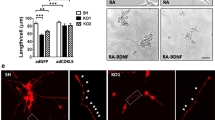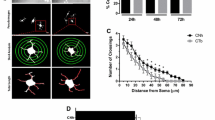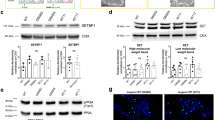Abstract
Aberrant formation of the cerebral cortex could be attributed to the lack of suitable substrates that direct the migration of neurons. Previous work carried out at our laboratory has shown that oleic acid is a neurotrophic factor. In order to characterize the effect of oleic acid in a cellular model of Down’s syndrome (DS), here, we used immortalized cell lines derived from the cortex of trisomy Ts16 and euploid mice. We report that in the plasma membrane of euploid cells, an increase in phosphatidylcholine concentrations occurs in the presence of oleic acid. However, in trisomic cells, oleic acid failed to increase phosphatidylcholine incorporation into the plasma membrane. Gene expression analysis of trisomic cells revealed that the phosphatidylcholine biosynthetic pathway was deregulated. Taken together, these results suggest that the overdose of specific genes in trisomic lines delays differentiation in the presence of oleic acid. The dual-specificity tyrosine (Y) phosphorylation-regulated kinase 1A (DYRK1A) gene is located on human chromosome 21. DYRK1A contributes to intellectual disability and the early onset of Alzheimer’s disease in DS patients. Here, we explored the potential role of Dyrk1A in the reduction of phosphatidylcholine concentrations in trisomic cells in the presence of oleic acid. The downregulation of Dyrk1A by small interfering RNA (siRNA) in trisomic cells returned phosphatidylcholine concentrations up to similar levels to those of euploid cells in the presence of oleic acid. Thus, our results highlight the role of Dyrk1A in brain development through the modulation of phosphatidylcholine location, levels and synthesis.





Similar content being viewed by others
Abbreviations
- DS:
-
Down’s syndrome
- CNh:
-
Cerebral cortex cells of euploid mice
- CTb:
-
Cerebral cortex cells of trisomy 16 mice
- PC:
-
Phosphatidylcholine
- DYRK1A:
-
Dual-specificity tyrosine (Y)-regulated kinase
- ChAT:
-
Choline acetyltransferase
- BSA:
-
Bovine serum albumin
- DMEM:
-
Dulbecco’s modified Eagle’s medium
- FCS:
-
Fetal calf serum
- PBS:
-
Phosphate-buffered saline
- siRNA:
-
Small interfering RNA
- CKα:
-
Choline kinase alpha
- CCTα:
-
Choline cytidylyltransferase alpha
- CPT:
-
CDP-choline:1,2-diacylglycerol phosphocholinetransferase
- PEMT:
-
Phosphatidylethanolamine methyltransferase
- SAM:
-
S-Adenosylmethionine
References
Lejeune J, Gautier M, Turpin R (1959) Study of somatic chromosomes from 9 mongoloid children. C R Hebd Seances Acad Sci 248:1721–1722
Becker L, Mito T, Takashima S, Onodera K (1991) Growth and development of the brain in Down syndrome. Prog Clin Biol Res 373:133–152
Coyle JT, Oster-Granite ML, Gearhart JD (1986) The neurobiologic consequences of Down syndrome. Brain Res Bull 16:773–787
Aylward EH, Habbak R, Warren AC, Pulsifer MB, Barta PE, Jerram M, Pearlson GD (1997) Cerebellar volume in adults with Down syndrome. Arch Neurol 54:209–212
Teipel SJ, Hampel H (2006) Neuroanatomy of Down syndrome in vivo: a model of preclinical Alzheimer’s disease. Behav Genet 36:405–415
Golden JA, Hyman BT (1994) Development of the superior temporal neocortex is anomalous in trisomy 21. J Neuropathol Exp Neurol 53:513–520
Rachidi M, Lopes C (2010) Molecular and cellular mechanisms elucidating neurocognitive basis of functional impairments associated with intellectual disability in Down syndrome. Am J Intellect Dev Disabil 115:83–112
Cheng A, Haydar TF, Yarowsky PJ, Krueger BK (2004) Concurrent generation of subplate and cortical plate neurons in developing trisomy 16 mouse cortex. Dev Neurosci 26:255–265
Haydar TF, Blue ME, Molliver ME, Krueger BK, Yarowsky PJ (1996) Consequences of trisomy 16 for mouse brain development: corticogenesis in a model of Down syndrome. J Neurosci 16:6175–6182
Antonarakis SE, Lyle R, Dermitzakis ET, Reymond A, Deutsch S (2004) Chromosome 21 and Down syndrome: from genomics to pathophysiology. Nat Rev Genet 5:725–738
Tejedor FJ, Hammerle B (2011) MNB/DYRK1A as a multiple regulator of neuronal development. FEBS J 278:223–235
Dowjat WK, Adayev T, Kuchna I, Nowicki K, Palminiello S, Hwang YW, Wegiel J (2007) Trisomy-driven overexpression of DYRK1A kinase in the brain of subjects with Down syndrome. Neurosci Lett 413:77–81
Guimera J, Casas C, Estivill X, Pritchard M (1999) Human minibrain homologue (MNBH/DYRK1): characterization, alternative splicing, differential tissue expression, and overexpression in Down syndrome. Genomics 57:407–418
Tejedor F, Zhu XR, Kaltenbach E, Ackermann A, Baumann A, Canal I, Heisenberg M, Fischbach KF et al (1995) minibrain: a new protein kinase family involved in postembryonic neurogenesis in Drosophila. Neuron 14:287–301
Altafaj X, Dierssen M, Baamonde C, Martí E, Visa J, Guimerà J, Oset M, González JR et al (2001) Neurodevelopmental delay, motor abnormalities and cognitive deficits in transgenic mice overexpressing Dyrk1A (minibrain), a murine model of Down’s syndrome. Hum Mol Genet 10:1915–1923
Dorsey SG, Bambrick LL, Balice-Gordon RJ, Krueger BK (2002) Failure of brain-derived neurotrophic factor-dependent neuron survival in mouse trisomy 16. J Neurosci 22:2571–2578
Tabernero A, Velasco A, Granda B, Lavado EM, Medina JM (2002) Transcytosis of albumin in astrocytes activates the sterol regulatory element-binding protein-1, which promotes the synthesis of the neurotrophic factor oleic acid. J Biol Chem 277:4240–4246
Mollgard K, Dziegielewska KM, Saunders NR, Zakut H, Soreq H (1988) Synthesis and localization of plasma proteins in the developing human brain. Integrity of the fetal blood-brain barrier to endogenous proteins of hepatic origin. Dev Biol 128:207–221
Velasco A, Tabernero A, Medina JM (2003) Role of oleic acid as a neurotrophic factor is supported in vivo by the expression of GAP-43 subsequent to the activation of SREBP-1 and the up-regulation of stearoyl-CoA desaturase during postnatal development of the brain. Brain Res 977:103–111
Saunders NR, Mollgard K (1981) The natural internal environment of the developing brain beyond the barrier. Trends Neurosci 4:56–60
Clarke CS, Bannon FJ (2005) Serum albumin in Down syndrome with and without Alzheimer’s disease. Ir J Med Sci 174:4–8
Tabernero A, Lavado EM, Granda B, Velasco A, Medina JM (2001) Neuronal differentiation is triggered by oleic acid synthesized and released by astrocytes. J Neurochem 79:606–616
Rodriguez-Rodriguez RA, Tabernero A, Velasco A, Lavado EM, Medina JM (2004) The neurotrophic effect of oleic acid includes dendritic differentiation and the expression of the neuronal basic helix-loop-helix transcription factor NeuroD2. J Neurochem 88:1041–1051
Hijazi M, Fillat C, Medina JM, Velasco A (2013) Overexpression of DYRK1A inhibits choline acetyltransferase induction by oleic acid in cellular models of Down syndrome. Exp Neurol 239:229–234
Massarelli R, Ferret B, Sorrentino G, Hattori H, Kanfer JN (1988) Choline acetyltransferase-like activity bound to neuronal plasma membranes. Neurochem Res 13:1193–1198
Chung SY, Moriyama T, Uezu E, Uezu K, Hirata R, Yohena N, Masuda Y, Kokubu T et al (1995) Administration of phosphatidylcholine increases brain acetylcholine concentration and improves memory in mice with dementia. J Nutr 125(6):1484–9
Avila-Martin G, Galan-Arriero I, Gomez-Soriano J, Taylor J (2011) Treatment of rat spinal cord injury with the neurotrophic factor albumin-oleic acid: translational application for paralysis, spasticity and pain. PLoS One 6, e26107
Cardenas AM, Rodríguez MP, Cortés MP, Alvarez RM, Wei W, Rapoport SI, Shimahara T, Caviedes R et al (1999) Calcium signals in cell lines derived from the cerebral cortex of normal and trisomy 16 mice. Neuroreport 10:363–369
Saud K, Arriagada C, Cárdenas AM, Shimahara T, Allen DD, Caviedes R, Caviedes P (2006) Neuronal dysfunction in Down syndrome: contribution of neuronal models in cell culture. J Physiol Paris 99:201–210
Bligh EG, Dyer WJ (1959) A rapid method of total lipid extraction and purification. Can J Biochem Physiol 37:911–917
Marcucci H, Paoletti L, Jackowski S, Banchio C (2010) Phosphatidylcholine biosynthesis during neuronal differentiation and its role in cell fate determination. J Biol Chem 285:25382–25393
Polo-Hernandez E, De Castro F, Garcia-Garcia AG, Tabernero A, Medina JM (2010) Oleic acid synthesized in the periventricular zone promotes axonogenesis in the striatum during brain development. J Neurochem 114:1756–1766
Hamilton LK, Dufresne M, Joppé SE, Petryszyn S, Aumont A, Calon F, Barnabé-Heider F, Furtos A et al (2015) Aberrant lipid metabolism in the forebrain niche suppresses adult neural stem cell proliferation in an animal model of Alzheimer’s disease. Cell Stem Cell 17:397–411
Garcia-Garcia AG, Polo-Hernandez E, Tabernero A, Medina JM (2015) Alpha-fetoprotein (AFP) modulates the effect of serum albumin on brain development by restraining the neurotrophic effect of oleic acid. Brain Res 1624:45–58
Laffaire J, Rivals I, Dauphinot L, Pasteau F, Wehrle R, Larrat B, Vitalis T, Moldrich RX, Rossier J, Sinkus R, Herault Y, Dusart I, Potier MC (2009) Gene expression signature of cerebellar hypoplasia in a mouse model of Down syndrome during postnatal development. BMC Genomics 10:138
Roper RJ, Baxter LL, Saran NG, Klinedinst DK, Beachy PA, Reeves RH (2006) Defective cerebellar response to mitogenic Hedgehog signaling in Down [corrected] syndrome mice. Proc Natl Acad Sci U S A 103:1452–1456
Murphy EJ, Schapiro MB, Rapoport SI, Shetty HU (2000) Phospholipid composition and levels are altered in Down syndrome brain. Brain Res 867:9–18
Elul R, Hanley J, Simmons JQ 3rd (1975) Non-gaussian behavior of the EEG in Down’s syndrome suggests decreased neuronal connections. Acta Neurol Scand 51:21–28
Medina JM, Tabernero A (2002) Astrocyte-synthesized oleic acid behaves as a neurotrophic factor for neurons. J Physiol Paris 96:265–271
Caviedes P, Ault B, Rapoport SI (1990) Electrical membrane properties of cultured dorsal root ganglion neurons from trisomy 19 mouse fetuses: a comparison with the trisomy 16 mouse fetus, a model for Down syndrome. Brain Res 511:169–172
Lopez S, Bermudez B, Montserrat-de la Paz S, Jaramillo S, Varela LM, Ortega-Gomez A, Abia R, Muriana FJ (2014) Membrane composition and dynamics: a target of bioactive virgin olive oil constituents. Biochim Biophys Acta 1838:1638–1656
Planque C, Dairou J, Noll C, Bui LC, Ripoll C, Guedj F, Delabar JM, Janel N (2013) Mice deficient in cystathionine beta synthase display increased Dyrk1A and SAHH activities in brain. J Mol Neurosci 50:1–6
Acknowledgments
This work was supported by the Ramón Areces Foundation (M.H.) and Samuel Solórzano Foundation, University of Salamanca, Spain (A.V.). We are grateful to C. Raposo for helping with the chromatographic analysis by HPLC carried out at the Mass Spectrometry facilities of the University of Salamanca and to T. del Rey for the technical assistance.
Author information
Authors and Affiliations
Corresponding author
Rights and permissions
About this article
Cite this article
Hijazi, M., Medina, J.M. & Velasco, A. Restrained Phosphatidylcholine Synthesis in a Cellular Model of Down’s Syndrome is Associated with the Overexpression of Dyrk1A. Mol Neurobiol 54, 1092–1100 (2017). https://doi.org/10.1007/s12035-016-9728-2
Received:
Accepted:
Published:
Issue Date:
DOI: https://doi.org/10.1007/s12035-016-9728-2




